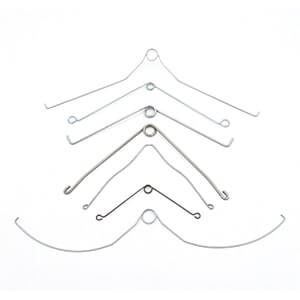Get unique, complex parts easily. No matter your requirements, Chaoyi Spring creates hard-to-produce coil springs and wire forms.
Let us help you create the custom wire form you need, from S-hooks and J-hooks to utility hooks and more.
We work closely with customers across a wide range of industries, helping them design and manufacture made-to-order parts.
Why choose Chaoyi Spring? We prioritize customer-focused collaboration, modern equipment and the latest technology to make your parts per print.
Find the information and guidance you need, from measuring a spring to learning about materials, placing an order and much more.
When it comes to springs, the world of engineering is filled with diverse options, each tailored to specific needs and applications. Two of the most common types are torsion springs


When it comes to springs, the world of engineering is filled with diverse options, each tailored to specific needs and applications. Two of the most common types are torsion springs and extension springs, each possessing unique characteristics and serving distinct purposes. Understanding the differences between these two is crucial for selecting the right spring for a particular project, ensuring optimal performance and longevity. This article delves into the intricacies of torsion springs and extension springs, highlighting their contrasting functionalities, advantages, and applications in various industries. By dissecting their mechanics and exploring their usage, we aim to provide a comprehensive guide for navigating the selection of the ideal spring for your specific needs.

Torsion springs, also known as twist springs, are designed to store and release energy through twisting or rotational motion. Imagine a spring wound around a central axis; when you apply a torque to one end, the spring twists along that axis. The force exerted by the spring is proportional to the angle of twist. This unique characteristic makes them perfect for applications requiring controlled rotational movement, such as opening and closing doors, activating switches, and providing tension in machinery. They are commonly found in various everyday items like door hinges, garage door openers, and even the winding mechanism of watches.
Extension springs, on the other hand, are designed to store and release energy through stretching or extending. They are typically coiled, like a slinky, with their coils touching when relaxed. Applying a force pulls the spring apart, increasing its length. The force exerted by the spring is directly proportional to its extension. Extension springs are commonly used in applications requiring a pushing or pulling force, such as in automotive suspension systems, spring-loaded clamps, and retractable pens.
While both torsion springs and extension springs serve the purpose of storing and releasing energy, their fundamental differences lie in their load application and resulting motion. Torsion springs work by twisting, while extension springs operate by stretching. This key difference dictates their suitability for specific applications.
Let's explore these differences in more detail:
Torsion springs experience a load as torque, a twisting force, while extension springs are subjected to a tensile load, pulling them apart. This distinction plays a significant role in their functionality.
Torsion springs produce rotational motion when loaded, whereas extension springs result in linear motion, either pulling or pushing.
The force generated by a torsion spring is measured as torque, the tendency of a force to rotate an object around an axis, while the force of an extension spring is measured as a linear force, acting along a straight line.
Torsion springs are subjected to shear stress, a stress that causes the material to deform by twisting. Extension springs experience tensile stress, a stress that causes the material to deform by pulling.
Both torsion springs and extension springs find widespread applications in various industries and products, demonstrating their versatility and importance in modern engineering.
Torsion springs, with their rotational capabilities, are ideal for applications that require controlled movement, such as:
Extension springs, with their ability to stretch and retract, are essential for various applications that require a pulling or pushing force, such as:
When selecting the appropriate spring for your project, several factors should be considered to ensure optimal performance and longevity.
Determine the maximum load or force that the spring will be subjected to, ensuring it can withstand the required stress without failure.
Calculate the required deflection or change in length or angle of twist.
Consider the material of the spring, as different materials offer varying levels of strength, durability, and resistance to corrosion.
Take into account the environmental conditions, such as temperature, humidity, and exposure to chemicals.
Evaluate the cost of the spring, considering factors such as material, manufacturing, and quantity.
Choosing the right spring can significantly impact the performance and longevity of any product or system. By understanding the fundamental differences between torsion springs and extension springs, their applications, and crucial selection considerations, engineers and designers can confidently select the ideal spring for their specific needs. Whether powering rotational movements with torsion springs or handling linear forces with extension springs, the correct spring choice can pave the way for success in any project.
The world of springs is diverse and fascinating, offering a multitude of options tailored to various applications. By understanding the differences between torsion springs and extension springs, their unique characteristics, and the factors influencing their selection, you can confidently choose the spring that will meet the specific needs of your project. From powering intricate machinery to ensuring the smooth operation of everyday objects, springs play a pivotal role in our modern world, and selecting the right spring can make all the difference.
Browse some of the custom wire forms and springs that we manufacture. Don’t see what you need? We specialize in made-to-order products that meet your application requirements.
Visit Our GalleryNeed a custom wire form or coil spring? We make it work. Fill out the contact form and a representative will respond within 1 business day. If you have a PDF or CAD file, you can submit to request a quote.